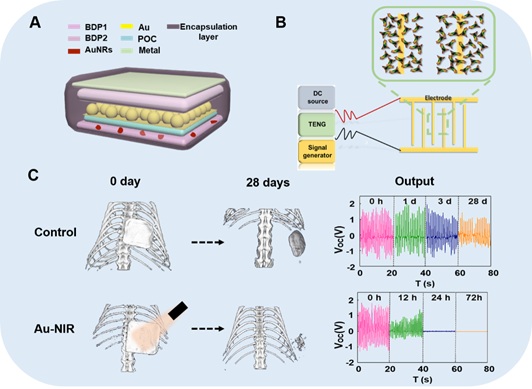With the increasing incidence of cardiovascular diseases and neurological diseases, the requirements for implantable electronic medical devices are getting higher and higher. However, the existing implanted electronic devices still have some problems, such as limited power supply life and need to be removed after treatment. Therefore, there is an urgent need to develop a new implantable electronic device to provide a feasible solution to the above problems.
As a self-energy energy conversion device, the friction nano-generator has a unique working method: frictional electrification and electrostatic induction, and high energy conversion efficiency. It can be used to power implantable electronic devices and used for cardiac pacing, Health monitoring and cell tissue engineering. The biodegradable implantable electronic medical device can be degraded and absorbed by the organism itself after completing its established tasks, avoiding secondary surgery, thereby reducing the psychological and economic burden of the patient. Therefore, the degradable nano-generator can solve the existing problems of implantable electronic devices.
So far, researchers have developed several degradable friction nano-generators. In 2016, the team of researchers Li Zhou and Wang Zhonglin of the Beijing Institute of Nano Energy and Systems, Chinese Academy of Sciences reported for the first time a biodegradable friction nano-generator, which can be completely degraded without side effects after nine weeks of implantation in rats . In 2018, the research team successfully prepared different types of pure natural bio-absorbable friction nano-generators and used them for myocardial cell stimulation, providing new treatments for diseases such as slow heart rate and arrhythmia.
Recently, the team of Li Zhou, Li Linlin and Wang Zhonglin of the Beijing Nano Energy Institute further studied the controllable degradation behavior of degradable nano-generators and used it for tissue repair and wound healing. PhD student Li Zhe and associate researcher Feng Hongqing and other researchers used the photothermal properties of gold nanorods to prepare a photothermally controlled degradable friction nano-generator (BD-iTENG). The BD-iTENG doped with gold nanorods is irradiated with near-infrared light to realize the conversion of light energy into heat energy, thereby adjusting the degradation behavior of the friction nanogenerator. The experimentally prepared PLGA-BD-iTENG can achieve rapid degradation in 28 days in vitro and 14 days in vivo. At the same time, the device has good biocompatibility and biosecurity.
BD-iTENG can collect mechanical energy inside and outside the body and convert it into electrical energy. Therefore, BD-iTENG can be used as a power source for bioelectric stimulation to promote tissue repair and wound healing. Experiments show that the BD-iTENG can significantly accelerate the migration of fibroblasts across scratches, and provide new ideas for electrical stimulation to promote tissue repair.

Figure: (A) Schematic diagram of a controllable degradation friction nano-generator; (B) Schematic diagram of an electrical stimulation device; (C) Physical degradation picture and output changes in a controllable degradation generator.
PP staple fiber(pp fiber) needle punched geotextile is manufactured using short synthetic fabric (polypropylene fiber) as main materials. The product is formed after the processes of opening,combing, mixing and disordering,lapping and needling .
PP Needle Punched Nonwoven Geotextile
Pp Needle Punched Nonwoven Geotextile, Polypropylene Nonwoven Geotextile, Staple Fiber Needlepunched Nonwoven Geotextile
Feicheng Lianyi Engineering Plastics Co., Ltd , https://www.lianyigeosynthetics.com